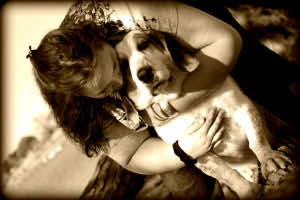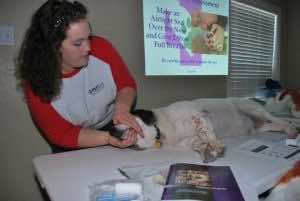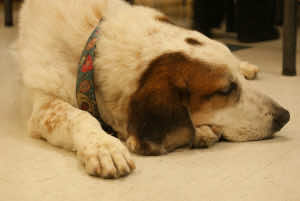(Long post, but worth every word!)
Simple Answer: You don’t unless you’re forced to.
Ask anyone who has been in the position of the “rescuer” performing the adrenaline-pumping whirlwind procedure of CPR on a beloved pet, and they will tell you how incredibly time-altering it is.
Although I have told this story in my Pet CPR & First Aid classes, this will be the first time since that fateful day that I have told his story in the written word and telling strangers on social media. I promise that although this pains me to write, even in brief detail, I do not want you to cry with me… I tell you his story so that you can learn from him. Our mission to change and improve pet’s lives will live on through his story.
Burt’s Story
Burt was unique, to say the least.
Burt was utterly amazing, to say the most.
As many of you know, I teach Pet CPR & First Aid to Pet Owners and Pet Care Professionals alike across the state of Texas. Burt was my absolute everything, and in 2013, my world came to a sudden halt the day that I had to perform CPR on my own President Pet CPR Demo Dog.
Flashback 13 years ago, I traveled about 4 hours away (twice) to this small unknown Texas town with a tiny rundown county shelter after I found this intriguing dog on Petfinder when I was 18 years old. While he was not my family’s first dog, he was MY first dog. My mother was adamant that I was not getting a dog, but my rebellion period had a late start. So I went and got my dog. He was my everything and experienced all of my “first’s” right along with me! When I moved out of my mom’s house to a brand new city, started new jobs, got my first apartment and later a house, met the loves of my life, and moved around Houston and Dallas, finding myself… As many first dog owners in their 20’s can relate, he was my only constant on that journey in my life.

He had HORRIBLE separation anxiety in the early years… his bark was sure to get me evicted! I couldn’t deny he was as obsessed with me as I was with him! ;o) So luckily, working in the animal field, I took him to work with me every day! (Now, as a dog trainer, I have some OTHER recommendations for separation anxiety, but I was green then! ;o))
Once my reputation and knowledge began to grow through the years, I started doing public demonstrations and events, and Burt began to build his own reputation! At one point, he had more Facebook friends than I did! The first cue he ever learned was “sleep.” And he did it so well that in 2007 when I was introduced to Pet Tech, I became a Certified Pet Tech Instructor so that Burt and I could start educating the public in Pet CPR, First Aid & Care For Your Pets. It merged my two passions of education and my medical background as a veterinary nurse, and Burt played unconscious very well!

Burt was the gentle giant. 110lbs – Basset Hound – Great Pyrenees mix who was 5 feet long and 2 feet tall, and he got attention EVERYWHERE we went!
One Decision Against My Gut Turned My World Upside Down…
One particular day, I decided to mix all my dogs so they could all keep each other company, knowing it was going to be a long evening and night away from them because I had an overnight pet sitting visit. Something in my gut stopped me, thinking it would be too long with everyone together and no supervision, but I quickly dismissed the feeling and proceeded along. When I arrived home the next morning, my fosters had escaped out of their kennels, and Burt was covered with puncture wounds, in severe shock, and covered in blood. A fight had broken out, and my suspicions was it was a pack-involved attack… the details that I will never know still haunt me to this day. I immediately rushed him to the veterinary clinic that I worked for which he was immediately seen and stabilized. He, unfortunately, fell into acute kidney failure shortly after due to the shock and trauma that his 12-year-old body couldn’t handle. Thus began the roller-coaster of events and emotions that resulted in 5 long days with me as a constant at his side. I am so incredibly blessed to work for a facility (knowing that I had a Veterinary Nurse background) that let me literally “camp” out at the hospital so that I could see to it that he got round-the-clock care.

He began to show improvement on the 5th day (on a Monday), so I left briefly to go home and shower and grab something to eat. When I got back, I was on the phone with my vet talking about him possibly going home that Friday! I was in good spirits and was unhooking his IV line set so that he could get out and go potty. He was very anxious to get out of his kennel, so I hung up with her and hurried to let him get out.
The Unthinkable…
My life flashed before my eyes as I held him up, supporting him as he walked to go potty. He crashed! My 110lb baby dog went limp in my arms, and my life as I knew it crashed right along with him. My cell battery was on 1%, and I made two phone calls. One to my vet and one to my veterinary nurses. They were on their way…
I know Pet CPR!
I teach Pet CPR!
I performed Pet CPR… all to no avail…
In many circumstances, CPR is not always successful, but I was not going to give up! I performed CPR for over 30 minutes until my help arrived. We attempted epinephrine injections. We placed a tracheal tube and filled his lungs with fresh oxygen. They attempted CPR compressions until my vet said the fateful final words… “I’m sorry Beth… he’s gone…” and my world went black…

I was beyond exhausted… adrenaline crash, panic, shock, a well of un-vented emotions (You can’t scream and cry and perform CPR at the same time!) and the physical exertion that your body goes through doing hard and fast compressions for that long completely robs you of every ounce of energy you think you have left!
I, of ALL people, should have been able to save him…
I know this skill like the back of my hand. I teach this skill from memory to hundreds of students each year. I still questioned every single move I made that evening. Did I do the compressions correctly? Did I see his chest rise and fall? Pet Tech has a favorite saying, “You do the best you can, at any given time, with the resources you have.” We suspect that he had an aneurysm of some sort, but honestly, we will never know.

The only thing I do know is that no matter how long I did CPR that day, it would not have saved him. But I wasn’t the one who had to decide when that moment was. Other trained professionals came in to help, and they made that call for me. That, in a twisted way, helped me cope a little more in my grieving process. It prevented me from being able to ask myself the hardest question of all… “What if I had continued CPR for just a little longer?” or “Did I give up too soon?”
Become Pet CPR & First Aid Trained
Although CPR could not bring my Burt back… CPR is successful in A LOT of situations! What if this was you? What would you have done? Do you know how to perform Pet CPR for your pet? If you do, congratulations! If you don’t know, you should! In our PetSaver seminar, we always promote having other people around you trained properly in Pet CPR. When and if that situation arises, you have someone to rotate with during your 2-minute cycles. Between the panic, adrenaline, overexertion, and the feeling of hyperventilation when doing Rescue Breathing, after 2 minutes (which seems like 2 hours), there are moments when you feel like you can’t go on. When you have someone else rotating off with you, you are more likely to continue much longer than doing it all on your own! But if you are in that situation performing CPR alone… you will continue… because your love for that animal drives your energy…

We only tell people to stop CPR in 3 situations
1.) The pet becomes conscious (Obviously!)
2.) You hand over the care of your pet to a veterinarian when you arrive at the animal hospital
3.) You physically cannot do CPR any longer (You did the best you could with the resources you had and should be very proud of that!)
There is no “magic” time limit… I tell each of my students that it is a call they NEVER want to make. CPR is effective in many emergencies, so don’t ever give up on that hope unless you’re forced to! Being trained in Pet CPR is the first step! Being trained correctly and EFFECTIVELY in Pet CPR is even more important, though! Be sure to research your Pet CPR & First Aid classes in your area! Make sure they teach you the HANDS-ON skills so that you leave actually knowing how to place your hands most effectively and how to adjust your pet for the most effective Canine and Feline CPR chest compressions, based on the size and shape of your pet! If you’re ready to take that next step to make sure you know what to do to try to save your pet, visit us at www.DallasPetFirstAid.com!

